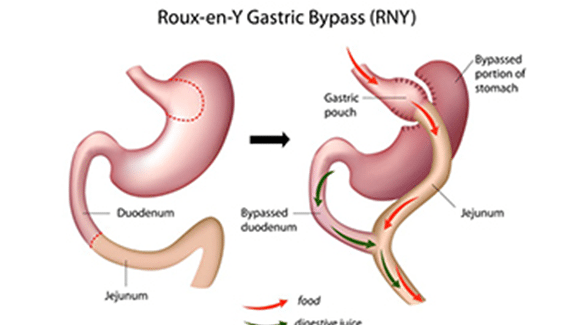A Roux-en-Y gastric bypass procedure is a surgical technique in which the stomach is divided into one small pouch and the remaining larger portion. The surgeon attaches the small pouch directly to the middle of the small intestine, skipping the area of the duodenum.
- The pouch can only hold about one ounce of food or beverage
- The typical adult stomach can hold up to three pints
- With the bypass procedure, you will feel full much faster


 People who are morbidly obese or who are obese and suffer from a concurrent health problem such as diabetes, heart disease, gastroesophageal reflux disease, or severe joint pain may benefit from having a Roux-en-Y procedure.
People who are morbidly obese or who are obese and suffer from a concurrent health problem such as diabetes, heart disease, gastroesophageal reflux disease, or severe joint pain may benefit from having a Roux-en-Y procedure. The Roux-en-Y gastric bypass is performed by a gastroenterologist, although other surgeons, an anesthesiologist and a team of nurses will assist during the procedure. To perform a Roux-en-Y procedure, the gastroenterologist either uses a laparoscopic or large incision to open the abdominal cavity. Laparoscopic procedures are the most commonly used technique because the incision is small and the patient spends less time in the hospital after the procedure. The healing time is also faster for a laparoscopic Roux-en-Y gastric bypass.
The Roux-en-Y gastric bypass is performed by a gastroenterologist, although other surgeons, an anesthesiologist and a team of nurses will assist during the procedure. To perform a Roux-en-Y procedure, the gastroenterologist either uses a laparoscopic or large incision to open the abdominal cavity. Laparoscopic procedures are the most commonly used technique because the incision is small and the patient spends less time in the hospital after the procedure. The healing time is also faster for a laparoscopic Roux-en-Y gastric bypass. Before a Roux-en-Y gastric bypass, most doctors will recommend lab tests to check for nutritional deficiencies and other medical issues. The doctors may recommend pre-surgical counseling for diet and nutrition. Patients are often asked to stop smoking and avoid the use of certain medications such as aspirin and blood thinners for a few weeks before the Roux-en-Y procedure. Most patients will need to complete an educational program before the Roux-en-Y gastric bypass so that they know what to expect after the procedure.
Before a Roux-en-Y gastric bypass, most doctors will recommend lab tests to check for nutritional deficiencies and other medical issues. The doctors may recommend pre-surgical counseling for diet and nutrition. Patients are often asked to stop smoking and avoid the use of certain medications such as aspirin and blood thinners for a few weeks before the Roux-en-Y procedure. Most patients will need to complete an educational program before the Roux-en-Y gastric bypass so that they know what to expect after the procedure. About 12 weeks after surgery, most patients are able to begin eating small amounts of their preferred foods. Patients may need regular lab tests to make sure that they do not have any vitamin or nutritional deficiencies. If any are found, the physician may prescribe a supplement to resolve them. The initial weight loss occurs quickly and many patients lose up to 10 pounds per week. As the recovery from Roux-en-Y gastric bypass surgery continues past the six month mark, the weight loss will slow. Ongoing dietary counseling and increased physical activity will help to ensure that patients achieve their weight loss goals after a
About 12 weeks after surgery, most patients are able to begin eating small amounts of their preferred foods. Patients may need regular lab tests to make sure that they do not have any vitamin or nutritional deficiencies. If any are found, the physician may prescribe a supplement to resolve them. The initial weight loss occurs quickly and many patients lose up to 10 pounds per week. As the recovery from Roux-en-Y gastric bypass surgery continues past the six month mark, the weight loss will slow. Ongoing dietary counseling and increased physical activity will help to ensure that patients achieve their weight loss goals after a